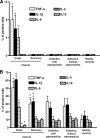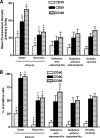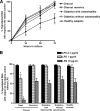Proinflammatory modulation of the surface and cytokine phenotype of monocytes in patients with acute Charcot foot
- PMID: 19880584
- PMCID: PMC2809281
- DOI: 10.2337/dc09-1141
Proinflammatory modulation of the surface and cytokine phenotype of monocytes in patients with acute Charcot foot
Abstract
Objective: Despite increased information on the importance of an inappropriate inflammatory response in the acute Charcot process, there has been no previous attempt to define the specific pathways that mediate its pathogenesis. Here, the role played by monocytes was analyzed.
Research design and methods: The immune phenotype of peripheral monocytes was studied by fluorescence-activated cell sorter analysis comparing patients with acute Charcot (n = 10) in both the active and recovered phase, diabetic patients with neuropathy (with or without osteomyelitis), and normal control subjects.
Results: When compared with diabetic control subjects and healthy subjects, monocytes from acute Charcot patients showed a proinflammatory immune phenotype characterized by increased production of proinflammatory cytokines, reduced secretion of anti-inflammatory cytokines, increased expression of surface costimulatory molecules, and increased resistance to serum withdrawal-induced apoptosis. In addition, the pattern of circulating cytokines confirmed activation of proinflammatory cytokines. No modulation of the monocyte phenotype was documented in diabetic control subjects and healthy subjects, thus indicating that the proinflammatory alterations of monocytes are specific and causative of acute Charcot.
Conclusions: Together, these data provide evidence for the role of proinflammatory changes in the immune phenotype of monocytes in the pathogenesis of acute Charcot. These alterations may explain the abnormally intense and prolonged inflammatory response that characterizes this disorder and may represent a potential therapeutic target for specific pharmacological interventions.
Figures



References
-
- La Fontaine J, Harkless LB, Sylvia VL, Carnes D, Heim-Hall J, Jude E. Levels of endothelial nitric oxide synthase and calcitonin gene-related peptide in the Charcot foot: a pilot study. J Foot Ankle Surg 2008; 47: 424– 429 - PubMed
-
- Jeffcoate W. Vascular calcification and osteolysis in diabetic neuropathy: is RANKL the missing link? Diabetologia 2004; 47: 1488– 1492 - PubMed
-
- Jeffcoate WJ, Game F, Cavanagh PR. The role of proinflammatory cytokines in the cause of neuropathic osteoarthropathy (acute Charcot foot) in diabetes. Lancet 2005; 366: 2058– 2061 - PubMed
MeSH terms
Substances
LinkOut - more resources
Full Text Sources
Medical

